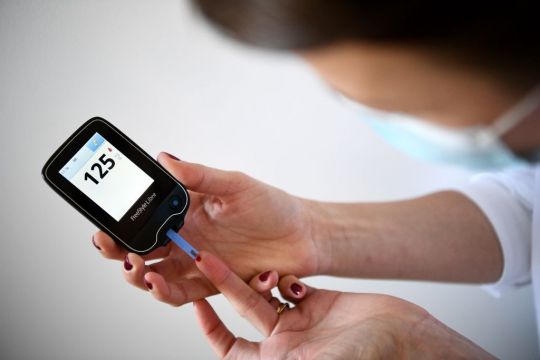It took the deadly disruption of the Covid-19 pandemic to expose a deeper, more intractable US public-health crisis: For more than a decade, the world’s richest nation has been losing the battle against diabetes.
Long before the pandemic, Kate Herrin was among the millions of Americans struggling to control their diabetes.
Her problems often stemmed from her government-subsidised medical insurance. Doctors routinely rejected her Medicaid plan, and she repeatedly ran out of the test strips she needed to manage her daily insulin injections. She cycled in and out of emergency rooms with dangerously high blood-sugar levels, or hyperglycemia.
Facebook messaging
Then Covid-19 hit. Herrin – poor and living alone – rarely left her apartment, ordering fast-food delivery instead of risking the grocery store. She stopped going in for regular lab tests. She had a harder time than ever securing medical supplies. Her health deteriorated further.
On December 15th, Herrin and Elicia Heaston, her best friend, were swapping messages on Facebook midday when Herrin abruptly dropped off the conversation. Heaston called Herrin’s phone and got no answer. When a few more hours passed without any word, Heaston and her husband drove from their home in rural West Alexandria, Ohio, to Herrin’s apartment nearby and pounded on the door. No lights were on, but they could hear the television.
Heaston called 911. When firefighters arrived, they found the 42-year-old dead on the bathroom floor. Herrin’s rescue dogs, Honey and Sugar, were lying quietly next to her.
The coroner attributed the heart attack that killed Herrin to complications of type 2 diabetes.
“She was afraid COVID would kill her,” Heaston said. “Instead, it isolated her, and her diabetes got worse. She didn’t need to die at 42.”
Covid links
Covid-19, which has killed more than 600,000 people in the United States, has had an especially devastating impact on the millions of Americans with diabetes. Health professionals and scientists noticed early on that many severely ill coronavirus patients also had the chronic disease. The US Centers for Disease Control and Prevention (CDC) cites research showing that 40% or more of the people who died with COVID-19 also had diabetes.
And those numbers don’t reflect the damage the pandemic inflicted on diabetes patients who, like Herrin, never got sick from the virus but fell victim to the isolation and disruption it caused.
Deaths from diabetes last year surged 17% to more than 100,000, based on a Reuters analysis of CDC data. Younger people – those ages 25 to 44 – suffered the sharpest increase, with a 29% jump in deaths. By comparison, all other deaths except those directly attributed to the coronavirus rose 6% last year, Reuters found.
This grim toll is the result of a public-health failure that long predates the pandemic – and that is almost certain to persist after Covid-19 abates. After years of advances in treating diabetes, progress stalled about a decade ago. Since then, despite billions of dollars spent on new treatments, the prognosis for people with diabetes has been getting worse as the number of patients with the disease has increased, especially among working-age and even younger people.
'It didn't have to be this bad'
Late in the last century and early in this one, medical breakthroughs steadily chipped away at rates of diabetes-related deaths and complications in the United States. But the trend reversed as rising obesity and its consequences — like diabetes, hypertension and cardiovascular disease — more than offset improved therapies.
From 2009 to 2015, CDC data show that among diabetes patients, rates of hospitalisation for hyperglycemic crises soared by 73%, and deaths by 55%. From 2010 to 2015, a jump in the rate of lower-limb amputations – always a risk for diabetes patients – erased more than one-third of a 20-year decline.
The sharpest increases in these numbers were among adults 44 and younger. A Reuters analysis of more recent state-level data found that the trend has persisted. By 2019, US deaths attributed primarily to diabetes reached their highest rate in eight years.
So when the pandemic struck, Americans with diabetes were in poorer health than they had been in years, increasing their vulnerability just as the virus overwhelmed the US healthcare system.
“It didn’t have to be this bad,” said Dr Robert Pearl, a Stanford Medical School professor and former chief executive of the Kaiser Permanente Medical Group. “If we had spent more time and effort toward preventing and better managing diabetes, thousands of patients wouldn’t have needed hospitalisation in the first place,” Pearl said. “And many of them would still be alive.”
The reasons for the worsening outlook for diabetes patients are rooted in the American lifestyle and medical system.
Sedentary and unhealthy lifestyles
More Americans are developing diabetes earlier, even in childhood, because of long-term societal shifts toward sedentary lifestyles and unhealthy diets, according to researchers and doctors. Younger patients often have a harder time managing their disease, develop complications faster, and tend to have less consistent access to medical care, doctors say.
Some patients ration their medications and limit doctor visits to avoid the hefty out-of-pocket costs of increasingly common high-deductible insurance plans, backed for years by employers, insurers and policymakers. The focus in US healthcare on treating crises over preventing them doesn’t help, downplaying the importance of lifestyle changes that could lessen the severity of the disease.
The magnitude of the increase has set us back 15 to 20 years
“Over and over again, the problem is worse in young adults, and there isn’t improvement in older adults,” said Ed Gregg, a former CDC researcher who is now a professor at Imperial College in London. “The magnitude of the increase has set us back 15 to 20 years.”
Dr Giuseppina Imperatore, who oversees disease surveillance and other areas in the CDC’s Division of Diabetes Translation, said that the recent trends on diabetic complications and deaths are “definitely concerning,” and that the agency is still trying to fully understand what’s driving the poor outcomes, particularly among younger adults. She also told Reuters that “the impact of the COVID pandemic on people with diabetes cannot be overstated.”
An American problem
The failure to effectively treat diabetes carries enormous consequences for patients, their families and society at large. Roughly 34 million people, or about 1 in 10 Americans, have diabetes.
Treating them costs more than $230 billion a year – more than the U.S. Navy’s annual budget – much of that borne by taxpayers through government-sponsored Medicare insurance for the elderly and Medicaid for the poor.
About 1.6 million people have type 1 diabetes, an autoimmune disease of unknown cause that requires lifelong insulin injections when the pancreas stops producing the hormone. Without insulin, cells are unable to absorb glucose, their primary source of energy, and the sugar builds up in the blood.
But the vast majority of patients, accounting for most of the increase in new cases in recent years, have type 2 diabetes, a chronic condition linked to genetics, weight gain and inactivity.
These patients’ bodies don’t make enough insulin or don’t use it well. Diet and exercise can help manage the disease, but many also need medication that helps them use the insulin their bodies produce. Many eventually require insulin injections.
Checking the numbers
For all diabetes patients, life revolves around checking their numbers. That means testing their current blood glucose levels several times a day. And it means visiting a lab every few months to test their hemoglobin A1c, a measure of their glucose levels over the preceding three months. The higher the number, the worse it can be for a patient.
Uncontrolled diabetes wreaks havoc on the body. Acute hyperglycemia can lead to coma or even death. Over time, the disease degrades blood vessels and damages major organs, leaving patients prone to heart disease, stroke, kidney failure, amputations and blindness.
Other countries have more of a safety net to get people through hard times
While the coronavirus battered diabetes patients around the world, the longer-term reversal of fortunes is a particularly American problem. The US mortality rate for diabetes was 42% higher than the average among 10 other industrialised countries in 2017, according to the Organization for Economic Cooperation and Development.
In the British medical journal Lancet, researchers in 2018 gave the United States a score of 62 out of 100 on the quality of diabetes care. Most Western European countries scored in the 90s. The United States trailed Libya, Iran and Vietnam.
“Other countries have more of a safety net to get people through hard times,” said Steven Woolf, a professor at the Virginia Commonwealth University School of Medicine who studies death rates from diabetes and other causes. “People here are more vulnerable to the economic shocks of job losses, the last recession and now the pandemic.”
Reversing the gloomy outlook for diabetes patients isn’t easy. Advances in medication and technology to help patients better manage their condition often fail to reach those whose access to care is hampered by their race, income or type of insurance, according to experts in diabetes and public health. And reducing those disparities, they said, would have to come with major investments in primary care and a coordinated effort to curb obesity and inactivity.
“The current approach has failed,” said Dr David Kerr, director of research and innovation at the Sansum Diabetes Research Institute in Santa Barbara, California. “And just creating more expensive pharmaceuticals is not going to cut it at a population level.”
The fear effect
In the early days of the COVID-19 pandemic, the CDC and other agencies recommended that hospitals and medical offices postpone elective procedures and nonessential visits to limit spread of the virus and keep the most vulnerable out of harm’s way. Doctor’s offices and clinics halted in-person appointments for many patients with chronic conditions like diabetes. Diabetes education classes and patient support groups disbanded.
Telehealth and phone calls helped fill the void, but not all care could be delivered remotely. Some patients didn’t get blood drawn for regular A1c readings. Some of the neediest patients didn’t have smartphones or a reliable internet connection. And after some wound-care centres closed, remote monitoring couldn’t provide care that relies on touch and feel, such as evaluating the chronic sores that diabetes patients are prone to suffer.
Many patients became fearful and reluctant to seek care – until they were in crisis. Sandra Arevalo, director of community and patient education at Montefiore Hospital in Nyack, New York, said she knew several patients who had amputations, were admitted to intensive care or died after delaying care. “The diagnosis was uncontrolled diabetes, but it was caused by COVID fear,” Arevalo said. “COVID caused more damage than we realised.”
Isolation and inactivity
Since the 1970s, more and more Americans are growing up and living in “obesogenic” environments where they get less exercise, eat more processed foods high in carbohydrates and fat, and gain excessive weight at an earlier age.
“It is our physical inactivity, diets and environmental conditions that have caused this,” said Woolf, the Virginia Commonwealth researcher. He was co-author of a recent study by the National Academies of Sciences, Engineering and Medicine that found that diabetes and other endocrine and metabolic diseases are killing working-age adults at faster rates than in prior decades, across all racial and ethnic groups.
The isolation and inactivity imposed by the pandemic compounded many of those risks, triggering medical emergencies and life-altering diagnoses for some young people.
At Children’s National Hospital in Washington, D.C., diagnoses of type 2 diabetes among patients 8 to 20 years old nearly tripled in the first year of the pandemic. The severity of the cases worsened, too. Among the new patients, 23% had diabetic ketoacidosis – a dangerous buildup of acid in the blood due to lack of insulin – compared with 4% a year earlier. Only five of the 141 new patients had COVID-19 when they were diagnosed.
Doctors said they believe that pandemic-induced school closures and decreased physical activity contributed to the spike. “It was really pointing us to the indirect effect of social distancing,” said Dr Brynn Marks, a pediatric endocrinologist at Children’s National. - Reuters







